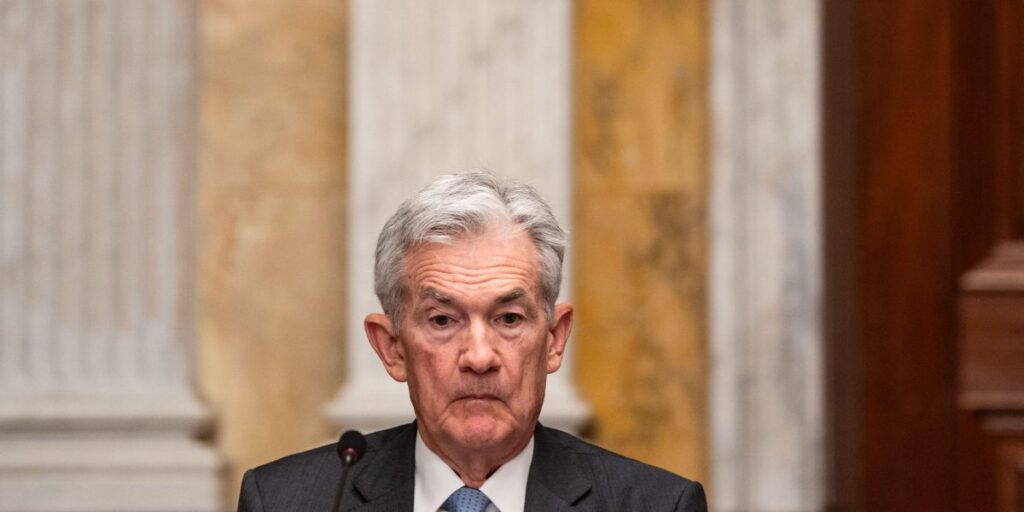
Economists are divided over how much of an interest rate cut Fed officials will signal in 2024 at next week’s policy meeting, following a recent surge in inflation data.
Policymakers may abandon their long-held forecast of three interest rate cuts this year, but whether they will still cut interest rates twice remains a close call. According to a Bloomberg survey, a 41% majority of economists expect the “dot plot” to show two rate cuts, while 41% expect the forecast to show only one rate cut or no rate cut at all.
The Federal Open Market Committee, which has kept its benchmark interest rate at a two-decade high since last July, plans to gradually lower rates this year, encouraged by a sharp fall in inflation in the second half of 2023. But due to a lack of progress starting in 2024, these plans have been postponed.
Ryan Sweet, chief U.S. economist at Oxford Economics, said in a survey response that “the Fed is waiting for a series of data to strengthen its view that inflation continues to move towards 2 % target is on track. “The balance of risks to our inflation forecast remains tilted to the upside. “
Officials are almost certain to hold rates steady in a range of 5.25% to 5.5% at their seventh consecutive meeting next week. Chairman Jerome Powell and colleagues will update their economic and interest rate forecasts at their June 11-12 meeting for the first time since March.
A reduction in the magnitude of the cuts indicates a later onset of the cuts. That could have an impact on November’s presidential election, although Fed officials unanimously said their decision was based solely on economic considerations.
Fed watchers expect the first rate cut to come at the central bank’s September policy meeting, the last gathering before voters vote on November 5. The annual gross domestic product growth rate is forecast to be 2.1%, and the unemployment rate at the end of the year is 4%.
The survey polled 43 economists between May 31 and June 5.
The vast majority of respondents said the Fed cut interest rates in response to declining inflation rather than labor market shortages or economic shocks. None of the economists said the next rate hike was very likely — a possibility that officials such as Minneapolis Fed President Neel Kashkari have occasionally mentioned.
Several Fed leaders have said in recent weeks that they see no rush to cut interest rates as inflation becomes more persistent and the growth outlook remains solid. As of April, inflation, the Fed’s preferred indicator, was 2.7%, and economists expect relatively little progress toward the Fed’s 2% target in the second half of the year compared with lower monthly numbers in late 2023.
Ahead of the self-imposed quiet period, Fed Governor Christopher Waller said the central bank could consider lowering interest rates “by the end of the year,” a view echoed by Atlanta Fed President Raphael Bostic. Cleveland Fed President Loretta Mester said she hopes to see “a few more months of inflation data that looks like it’s coming down,” while Boston Fed President Susan Collins said “patience really matters.” is very important.”
Almost all respondents expect the Fed to maintain its guidance on May 1 and that it would be inappropriate to cut interest rates until the central bank is more confident that inflation will continue to move towards 2%. Economists are divided over how the Federal Open Market Committee will characterize inflation, with most expecting the committee to reiterate the lack of recent progress.
“The FOMC may say there’s some encouraging data, but it needs to see more evidence to restore confidence,” said Luke Tilley, chief economist at Wilmington Trust.
At the meeting on the second day of next week, the government will report on the consumer price index for May. While the Fed focuses on individual price measures, the Consumer Price Index is expected to show continued cooling in inflation.
“The CPI will likely influence the tone of the FOMC,” said Stephanie Ross, chief economist at Wolff Research. “While we expect the inflation data to be tame, a number below 0.30% could be viewed as Seen as further evidence of slowing inflation.”
Since last July, Fed staff have been predicting a soft landing for the economy. Economists themselves are becoming increasingly optimistic about growth prospects. Only 3% of respondents predict a recession in the next 12 months, down from 58% last July.
While Fed leaders have been vague on which economic indicators would prompt a rate cut, 60% of economists said the important catalyst would be three consecutive positive core inflation reports. Inflation data from January to March were disappointing, and economists said an equal number of good reports would set the stage for a rate cut.
Beyond that, “clear evidence of a slowdown in the labor market” could prompt a cut in interest rates, said Elisabet Kopelman, U.S. economist at Skandinaviska Enskilda Banken AB.
The government’s May employment report released on Friday showed mixed labor market conditions. Although the unemployment rate rose and the labor force participation rate fell, employment and wage growth accelerated.
According to futures contracts, traders believe that the employment data may delay the timing of a net interest rate cut, which is currently expected to be about 1.5 basis points this year.

